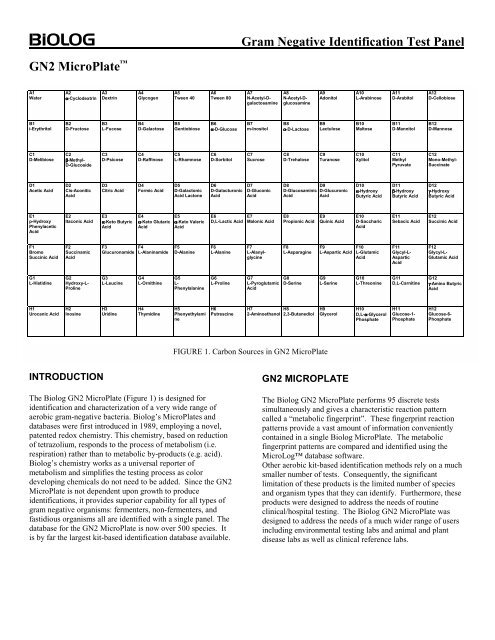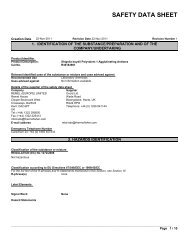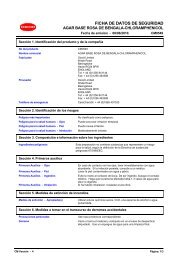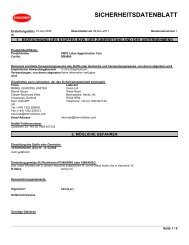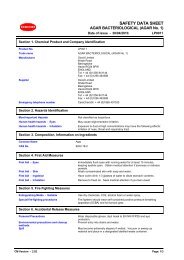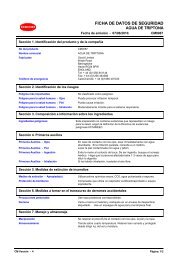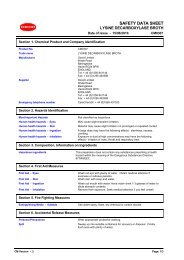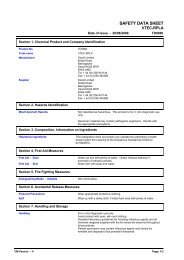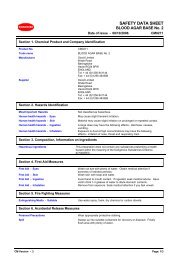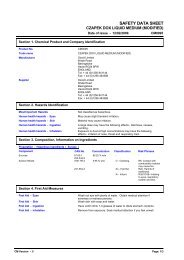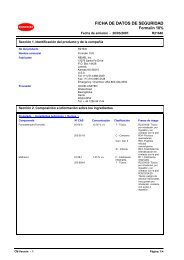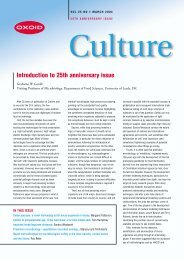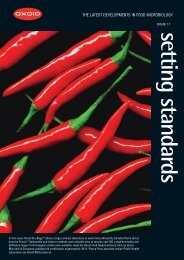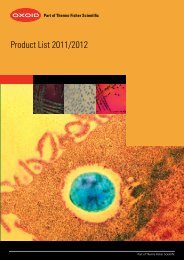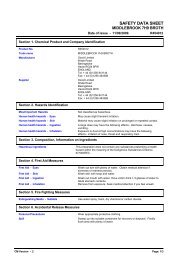Gram Negative Identification Test Panel GN2 MicroPlate™ - Oxoid
Gram Negative Identification Test Panel GN2 MicroPlate™ - Oxoid
Gram Negative Identification Test Panel GN2 MicroPlate™ - Oxoid
Create successful ePaper yourself
Turn your PDF publications into a flip-book with our unique Google optimized e-Paper software.
<strong>GN2</strong> MicroPlate <br />
A1<br />
Water<br />
B1<br />
i-Erythritol<br />
C1<br />
D-Melibiose<br />
D1<br />
Acetic Acid<br />
E1<br />
p-Hydroxy<br />
Phenylacetic<br />
Acid<br />
F1<br />
Bromo<br />
Succinic Acid<br />
G1<br />
L-Histidine<br />
H1<br />
Urocanic Acid<br />
A2<br />
α-Cyclodextrin<br />
B2<br />
D-Fructose<br />
C2<br />
β-Methyl-<br />
D-Glucoside<br />
D2<br />
Cis-Aconitic<br />
Acid<br />
E2<br />
Itaconic Acid<br />
F2<br />
Succinamic<br />
Acid<br />
G2<br />
Hydroxy-L-<br />
Proline<br />
H2<br />
Inosine<br />
INTRODUCTION<br />
A3<br />
Dextrin<br />
B3<br />
L-Fucose<br />
C3<br />
D-Psicose<br />
D3<br />
Citric Acid<br />
E3<br />
α-Keto Butyric<br />
Acid<br />
F3<br />
Glucuronamide<br />
G3<br />
L-Leucine<br />
H3<br />
Uridine<br />
A4<br />
Glycogen<br />
B4<br />
D-Galactose<br />
C4<br />
D-Raffinose<br />
D4<br />
Formic Acid<br />
E4<br />
α-Keto Glutaric<br />
Acid<br />
F4<br />
L-Alaninamide<br />
G4<br />
L-Ornithine<br />
H4<br />
Thymidine<br />
A5<br />
Tween 40<br />
B5<br />
Gentiobiose<br />
C5<br />
L-Rhamnose<br />
D5<br />
D-Galactonic<br />
Acid Lactone<br />
E5<br />
α-Keto Valeric<br />
Acid<br />
F5<br />
D-Alanine<br />
G5<br />
L-<br />
Phenylalanine<br />
H5<br />
Phenyethylami<br />
ne<br />
A6<br />
Tween 80<br />
B6<br />
α-D-Glucose<br />
C6<br />
D-Sorbitol<br />
D6<br />
D-Galacturonic<br />
Acid<br />
E6<br />
D,L-Lactic Acid<br />
F6<br />
L-Alanine<br />
G6<br />
L-Proline<br />
H6<br />
Putrescine<br />
The Biolog <strong>GN2</strong> MicroPlate (Figure 1) is designed for<br />
identification and characterization of a very wide range of<br />
aerobic gram-negative bacteria. Biolog’s MicroPlates and<br />
databases were first introduced in 1989, employing a novel,<br />
patented redox chemistry. This chemistry, based on reduction<br />
of tetrazolium, responds to the process of metabolism (i.e.<br />
respiration) rather than to metabolic by-products (e.g. acid).<br />
Biolog’s chemistry works as a universal reporter of<br />
metabolism and simplifies the testing process as color<br />
developing chemicals do not need to be added. Since the <strong>GN2</strong><br />
MicroPlate is not dependent upon growth to produce<br />
identifications, it provides superior capability for all types of<br />
gram negative organisms: fermenters, non-fermenters, and<br />
fastidious organisms all are identified with a single panel. The<br />
database for the <strong>GN2</strong> MicroPlate is now over 500 species. It<br />
is by far the largest kit-based identification database available.<br />
<strong>Gram</strong> <strong>Negative</strong> <strong>Identification</strong> <strong>Test</strong> <strong>Panel</strong><br />
A7<br />
N-Acetyl-Dgalactosamine<br />
B7<br />
m-Inositol<br />
C7<br />
Sucrose<br />
D7<br />
D-Gluconic<br />
Acid<br />
E7<br />
Malonic Acid<br />
F7<br />
L-Alanylglycine<br />
G7<br />
L-Pyroglutamic<br />
Acid<br />
A8<br />
N-Acetyl-Dglucosamine<br />
B8<br />
α-D-Lactose<br />
C8<br />
D-Trehalose<br />
A9<br />
Adonitol<br />
B9<br />
Lactulose<br />
C9<br />
Turanose<br />
D8<br />
D9<br />
D-Glucosaminic D-Glucuronic<br />
Acid<br />
Acid<br />
E8<br />
Propionic Acid<br />
F8<br />
L-Asparagine<br />
G8<br />
D-Serine<br />
H7<br />
H8<br />
2-Aminoethanol 2,3-Butanediol<br />
E9<br />
Quinic Acid<br />
F9<br />
L-Aspartic Acid<br />
G9<br />
L-Serine<br />
H9<br />
Glycerol<br />
FIGURE 1. Carbon Sources in <strong>GN2</strong> MicroPlate<br />
<strong>GN2</strong> MICROPLATE<br />
A10<br />
L-Arabinose<br />
B10<br />
Maltose<br />
C10<br />
Xylitol<br />
D10<br />
α-Hydroxy<br />
Butyric Acid<br />
E10<br />
D-Saccharic<br />
Acid<br />
F10<br />
L-Glutamic<br />
Acid<br />
G10<br />
L-Threonine<br />
H10<br />
D,L-α-Glycerol<br />
Phosphate<br />
A11<br />
D-Arabitol<br />
B11<br />
D-Mannitol<br />
C11<br />
Methyl<br />
Pyruvate<br />
D11<br />
β-Hydroxy<br />
Butyric Acid<br />
E11<br />
Sebacic Acid<br />
F11<br />
Glycyl-L-<br />
Aspartic<br />
Acid<br />
G11<br />
D,L-Carnitine<br />
H11<br />
Glucose-1-<br />
Phosphate<br />
A12<br />
D-Cellobiose<br />
B12<br />
D-Mannose<br />
C12<br />
Mono-Methyl-<br />
Succinate<br />
D12<br />
γ-Hydroxy<br />
Butyric Acid<br />
E12<br />
Succinic Acid<br />
F12<br />
Glycyl-L-<br />
Glutamic Acid<br />
G12<br />
γ-Amino Butyric<br />
Acid<br />
H12<br />
Glucose-6-<br />
Phosphate<br />
The Biolog <strong>GN2</strong> MicroPlate performs 95 discrete tests<br />
simultaneously and gives a characteristic reaction pattern<br />
called a “metabolic fingerprint”. These fingerprint reaction<br />
patterns provide a vast amount of information conveniently<br />
contained in a single Biolog MicroPlate. The metabolic<br />
fingerprint patterns are compared and identified using the<br />
MicroLog database software.<br />
Other aerobic kit-based identification methods rely on a much<br />
smaller number of tests. Consequently, the significant<br />
limitation of these products is the limited number of species<br />
and organism types that they can identify. Furthermore, these<br />
products were designed to address the needs of routine<br />
clinical/hospital testing. The Biolog <strong>GN2</strong> MicroPlate was<br />
designed to address the needs of a much wider range of users<br />
including environmental testing labs and animal and plant<br />
disease labs as well as clinical reference labs.
There are approximately 4,000 named bacterial species and<br />
this is just a fraction of the total number of species in the<br />
environment. The MicroLog System provides the unique<br />
feature of user defined custom databases. If an organism is<br />
outside the MicroLog database, the user can save the pattern to<br />
a custom database for future reference. If the organism is<br />
isolated again, the laboratory will have the pattern saved<br />
instead of simply getting a “no ID”. Some other methods<br />
provide supplemental off-line tests for use alongside the<br />
identification panel. This approach is inconvenient and does<br />
not produce an expanded pattern library.<br />
An identification from the Biolog <strong>GN2</strong> MicroPlate is superior<br />
to less precise methods, because:<br />
o The MicroLog System bases its identification on a<br />
larger number of tests. There are over 4 x 10 28<br />
possible patterns from a single MicroPlate<br />
o The MicroLog System covers far more species<br />
o Older methods were developed to detect routine<br />
clinical pathogens, and do not adequately identify<br />
other important organisms such as: Acinetobacter<br />
spp., Aeromonas spp., Bordetella spp., Haemophilus<br />
spp., Pseudomonas spp., Vibrio spp., and Yersinia<br />
spp.<br />
Various methods have different numbers and types of<br />
organisms within their database. Figure 2, compares several<br />
popular kit-based methods. The Biolog <strong>GN2</strong> MicroPlate has a<br />
much larger number of tests, which provides greater<br />
fingerprint discrimination and a larger database.<br />
Manufacturer Number of Aerobic<br />
Species in Database<br />
Biolog, Inc<br />
MicroLog<br />
BioMérieux<br />
Vitek ® GNI+<br />
bioMérieux API<br />
20E ® & NFT<br />
Part# OOA 003, Rev. A, Mar. 2001<br />
Number of <strong>Test</strong>s<br />
Used for Detection<br />
501 95<br />
104 29<br />
~180 20<br />
BBL ® Crystal ~105 28<br />
FIGURE 2. Comparison of Commercial <strong>Test</strong> Kits for<br />
<strong>Gram</strong> <strong>Negative</strong> Organisms<br />
In addition to a limited number of tests used to identify an<br />
unknown, some methods rely primarily on fermentation of<br />
sugars. This approach does not provide the necessary<br />
environment for every organism of interest. Many bacteria<br />
cannot utilize sugars via a fermentative process and react<br />
weakly or not at all with these methods. The larger number<br />
and more diverse range of tests in the <strong>GN2</strong> MicroPlate provide<br />
for greater accuracy and precision.<br />
<strong>Gram</strong> <strong>Negative</strong> <strong>Identification</strong> <strong>Test</strong> <strong>Panel</strong><br />
The <strong>GN2</strong> MicroPlate has demonstrated accuracy comparable<br />
to molecular methods and without the expense. Figure 3,<br />
provides representative results from an independent study with<br />
non-routine isolates compared to a molecular method:<br />
% Correct to the<br />
Species Level<br />
Biolog, Inc<br />
MicroLog<br />
Molecular Method<br />
Fermenters 80% 72%<br />
Nonfermenters 88% 100%<br />
Overall 85% 89%<br />
Figure 3: Comparison of Phenotypic and Genotypic<br />
Techniques 1<br />
PROCEDURE FOR USING <strong>GN2</strong> MICROPLATES<br />
The test procedure is fast and simple, involving only 5 steps,<br />
and requiring only 2 to 3 minutes hands-on time per sample.<br />
1) A pure culture of a bacterium is grown on a Biolog<br />
Universal Growth w/5% Sheep Blood agar plate<br />
(Biolog catalog #70101 for a 500g jar of dehydrated<br />
powder.)<br />
2) The bacteria are swabbed from the surface of the agar<br />
plate, and suspended to a specified density in GN/GP<br />
Inoculating Fluid (Biolog catalog # 72101).<br />
3) 150 µl of bacterial suspension is pipetted into each<br />
well of the <strong>GN2</strong> MicroPlate (Biolog catalog # 1011).<br />
4) The MicroPlate is incubated at 30° or 35 o C<br />
(depending upon the nature of the organism) for 4-24<br />
hours.<br />
5) The MicroPlates are read either visually or with the<br />
Biolog MicroStation or OmniLog System,<br />
compared to the GN Database (Biolog catalog #<br />
22401A), and a result is determined.<br />
REFERENCES:<br />
[1] Comparison of Phenotypic and Genotypic<br />
Techniques of <strong>Identification</strong> of Unusual Aerobic<br />
Pathogenic <strong>Gram</strong> <strong>Negative</strong> Bacilli. Y.W. Tang, N.M.<br />
Ellis, M.K. Hopkins, D.E. Dodge, and D.H. Persing,<br />
Journal of Clinical Microbiology, December 1998,<br />
p. 3674-3679<br />
CONTACT INFORMATION<br />
The Biolog Microbial <strong>Identification</strong>/Characterization System<br />
will be an invaluable addition to your microbiology<br />
laboratory.<br />
For more details, contact us using the information below:<br />
3938 Trust Way Hayward, CA 94545 Telephone: 510-785-2564 Fax: 510-782-4639 www.biolog.com


